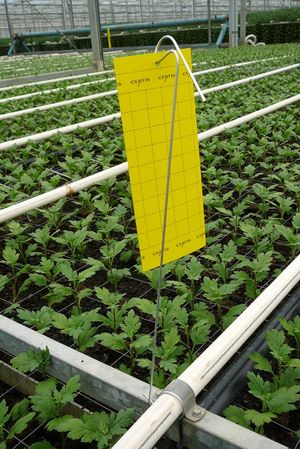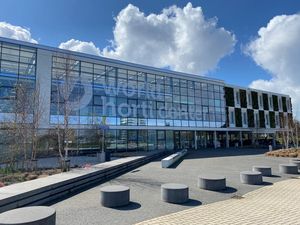More knowledge is required for optimal results from biorationals
The better the application of biorationals, the better the result. An example of a commonly used biorational in protected Chrysanthemum is BotaniGard

Research on the biorational Botanigard on thrips in Chrysanthemum

Certis Europe B.V. is working on practice-oriented research and development of biorationals from the CIC in Naaldwijk

“Collaboration is essential because crop protection is becoming more knowledge-intensive,” says Aron Boerefijn, Technical Advisor at Certis Europe
The better the application of a product, the better the result
Green crop protection products with an authorisation (biorationals) have attracted a lot of attention in recent years. This is partly due to the disappearance of conventional chemical products and because the emphasis on integrated crop protection is growing. Crop protection is increasingly becoming a complex system approach, which aims to keep the disease and pest pressure low from the start of cultivation. Biorationals fit well into this system approach because they can be combined with beneficials.
Future vision Crop Protection 2030
In Dutch greenhouse horticulture, Integrated Pest Management IPM) is already the norm, but the sector has greater ambitions. By 2030, agriculture and horticulture in the Netherlands will consist of sustainable production with resilient plants and cultivation systems, which means that diseases and pests will have far fewer opportunities and the use of crop protection products can be limited as much as possible. Where they are used, this will be in accordance with the principles of integrated crop protection. In order to achieve this ambitious goal, further innovation and cooperation in the value chain is necessary.
Resilient cultivation
IPM and resilient cultivation cannot exist without a good package of chemical and biological products. Even in a resilient cultivation system, the risk of diseases, pests and weeds remains present. A grower is constantly dealing with new developments and circumstances in cultivation and will have to respond to them. Crop protection products are and remain necessary in both conventional and organic cultivation. These resources must then be usable in an IPM setting and, just as importantly, they should not break down the resilience of the system, but rather support it.
Knowledge
Because more and more chemical products are disappearing, there is a lot of attention on biological crop protection products. Certis is the market leader in the field of these products, the so-called biorationals. In order to achieve an optimal result with these resources, more knowledge is often needed. The entire cycle from crop rotation to crop rotation must be correct. That requires a different way of thinking. What we need is more knowledge in the greenhouse, for example, of biology, of damage thresholds, of the operation of biorationals and of spraying techniques, because the better the application, the better the result. And that is of great importance now that the package of resources is changing.
Biorationals often have a short direct effect through contact and no residual effect or only a short one. The effective application of biorationals therefore often requires more knowledge and experience. Biorationals are frequently distinguished from conventional products by their very specific mode of action. In addition to knowledge of diseases and pests, a thorough knowledge of the product relating to mode of action, spraying technique and correct conditions during application is necessary to achieve a satisfactory result.
BotaniGard
An example of a commonly used biorational is the insecticide BotaniGard. The active substance of BotaniGard is an entomopathogenic fungus. Knowledge of the product and understanding of how it works is essential for effective use. There are two formulations of the product that can be used in various crops in the fight against insects such as thrips, whitefly and lettuce root borer. BotaniGard liquid is, in The Netherlands, only used and advised in the protected cultivation of Chrysanthemum. The WP (powder formulation) is advised in all other crops because of crop safety.
Mode of action
Like most biorationals, BotaniGard has a real contact action: the pest insects must be in direct contact with the product for effective control. The entomopathogenic fungus should germinate on the insect within 24-48 hours. The application technique is therefore very important, and the treatment will have to be repeated to have sufficient effect. One big advantage of this product is that it can be used almost all year round with the possibility of using a short spray interval. In ornamental crops, 73 applications per year are permitted and with that both thrips and whitefly can be kept permanently under pressure, especially when the product is combined with others such as the biological insecticide, Azatin, and when used alongside beneficials.
Application
In addition to a spray application, BotaniGard WP can also be applied very effectively via a space treatment (fogging and Low Volume Mist). Recent research by Certis, in which application methods were compared, showed that the result of a space treatment on whitefly in Lisianthus is at least as good as a spray. This method of application requires less work and, in addition, a shorter interval can be used. The label offers the possibility to apply Botanigard every five days. It can be used at the start of cultivation to support the beneficials and in this way will ensure that the insect pressure remains low.
Collaboration is essential
Crop protection is becoming much more knowledge-intensive than ever. The entire cycle from crop rotation to crop rotation must be correct, monitoring and early pest detection is vital, the spraying technique must be appropriate, and the means must be combinable with other products or beneficials. All of that requires more knowledge: more knowledge of the pest, the biorationals, the best conditions for effective application, damage thresholds and the complete picture that belongs to an integrated approach. To support distributors and growers, Certis has been working for a number of years from the Certis Innovation Center (CIC) in the greenhouse horticulture area of Westland in The Netherlands on practice-oriented research and the development of biorationals.
“Precisely because crop protection is becoming increasingly knowledge-intensive, a research location such as the CIC is very important,” says Aron Boerefijn, technical specialist for greenhouse horticulture at Certis. “At the moment, for example, we are constantly working on building our knowledge of biorationals,” he continues. “Think, for example, of testing the safety of biorationals on useful bugs and the efficacy on harmful bugs. Another example that I can mention is the aphid project, in which we look at the effectiveness of biological insecticides and the influence of spraying technique. With this type of research, we can optimally support commercial practice, both through trials and through education of advisors and growers,” Boerefijn concludes.
